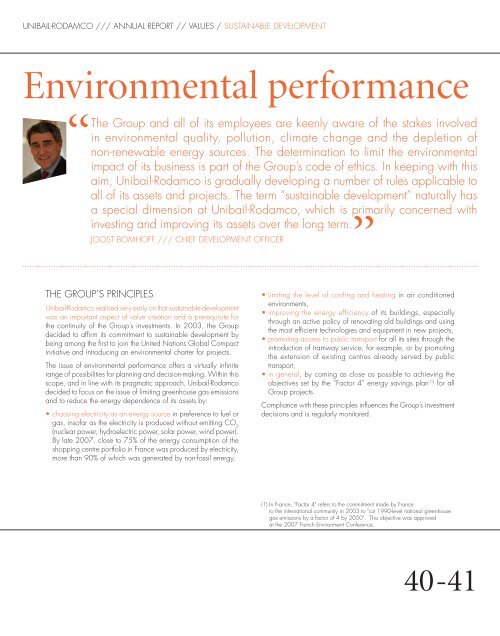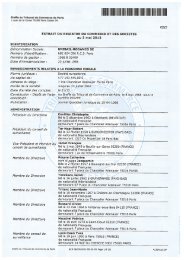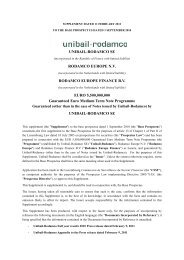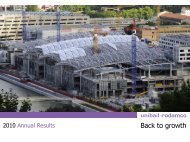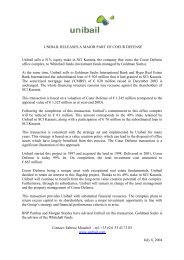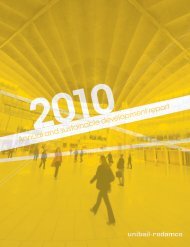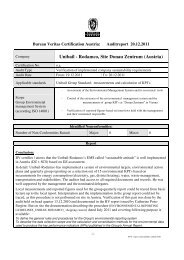2007 Unibail-Rodamco Annual Report (5,2 Mb)
2007 Unibail-Rodamco Annual Report (5,2 Mb)
2007 Unibail-Rodamco Annual Report (5,2 Mb)
Create successful ePaper yourself
Turn your PDF publications into a flip-book with our unique Google optimized e-Paper software.
UNIBAIL-RODAMCO /// ANNUAL REPORT // VALUES / SUSTAINABLE DEVELOPMENT<br />
Environmental performance<br />
‘‘<br />
The Group and all of its employees are keenly aware of the stakes involved<br />
in environmental quality, pollution, climate change and the depletion of<br />
non-renewable energy sources. The determination to limit the environmental<br />
impact of its business is part of the Group’s code of ethics. In keeping with this<br />
aim, <strong>Unibail</strong>-<strong>Rodamco</strong> is gradually developing a number of rules applicable to<br />
all of its assets and projects. The term “sustainable development” naturally has<br />
a special dimension at <strong>Unibail</strong>-<strong>Rodamco</strong>, which is primarily concerned with<br />
investing and improving its assets over the long term.<br />
’’<br />
JOOST BOMHOFF /// CHIEF DEVELOPMENT OFFICER<br />
THE GROUP’S PRINCIPLES<br />
<strong>Unibail</strong>-<strong>Rodamco</strong> realised very early on that sustainable development<br />
was an important aspect of value creation and a prerequisite for<br />
the continuity of the Group’s investments. In 2003, the Group<br />
decided to affi rm its commitment to sustainable development by<br />
being among the fi rst to join the United Nations Global Compact<br />
initiative and introducing an environmental charter for projects.<br />
The issue of environmental performance offers a virtually infi nite<br />
range of possibilities for planning and decision-making. Within this<br />
scope, and in line with its pragmatic approach, <strong>Unibail</strong>-<strong>Rodamco</strong><br />
decided to focus on the issue of limiting greenhouse gas emissions<br />
and to reduce the energy dependence of its assets by:<br />
• choosing electricity as an energy source in preference to fuel or<br />
gas, insofar as the electricity is produced without emitting CO 2<br />
(nuclear power, hydroelectric power, solar power, wind power).<br />
By late <strong>2007</strong>, close to 75% of the energy consumption of the<br />
shopping centre portfolio in France was produced by electricity,<br />
more than 90% of which was generated by non-fossil energy,<br />
• limiting the level of cooling and heating in air conditioned<br />
environments,<br />
• improving the energy efficiency of its buildings, especially<br />
through an active policy of renovating old buildings and using<br />
the most effi cient technologies and equipment in new projects,<br />
• promoting access to public transport for all its sites through the<br />
introduction of tramway service, for example, or by promoting<br />
the extension of existing centres already served by public<br />
transport,<br />
• in general, by coming as close as possible to achieving the<br />
objectives set by the “Factor 4” energy savings plan (1) for all<br />
Group projects.<br />
Compliance with these principles infl uences the Group’s investment<br />
decisions and is regularly monitored.<br />
(1) In France, "Factor 4" refers to the commitment made by France<br />
to the international community in 2003 to "cut 1990-level national greenhouse<br />
gas emissions by a factor of 4 by 2050". This objective was approved<br />
at the <strong>2007</strong> French Environment Conference.<br />
40-41


